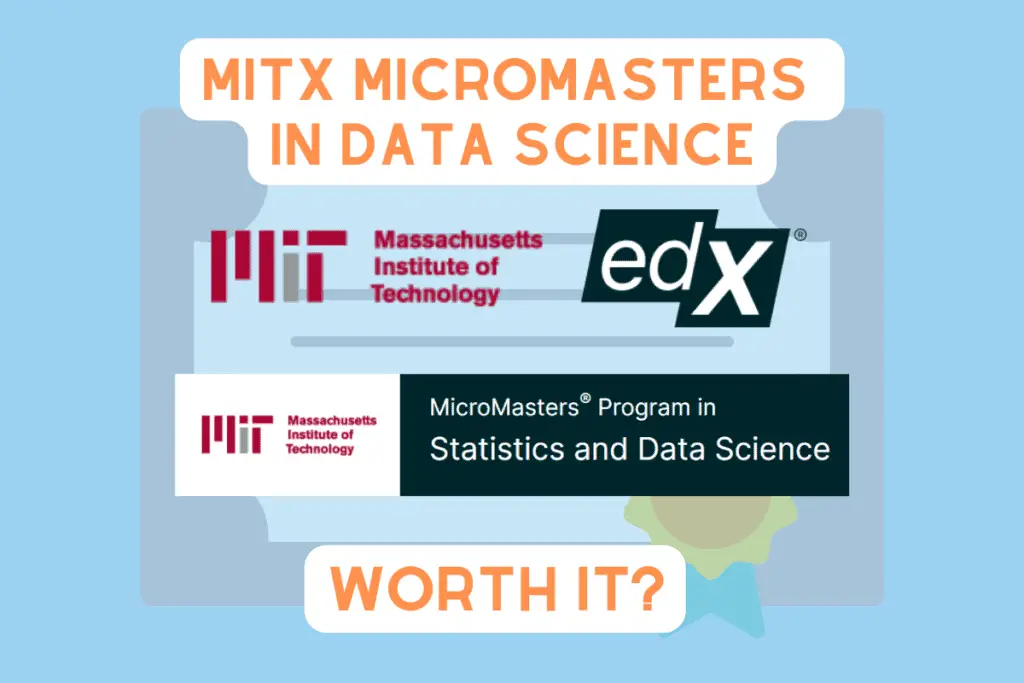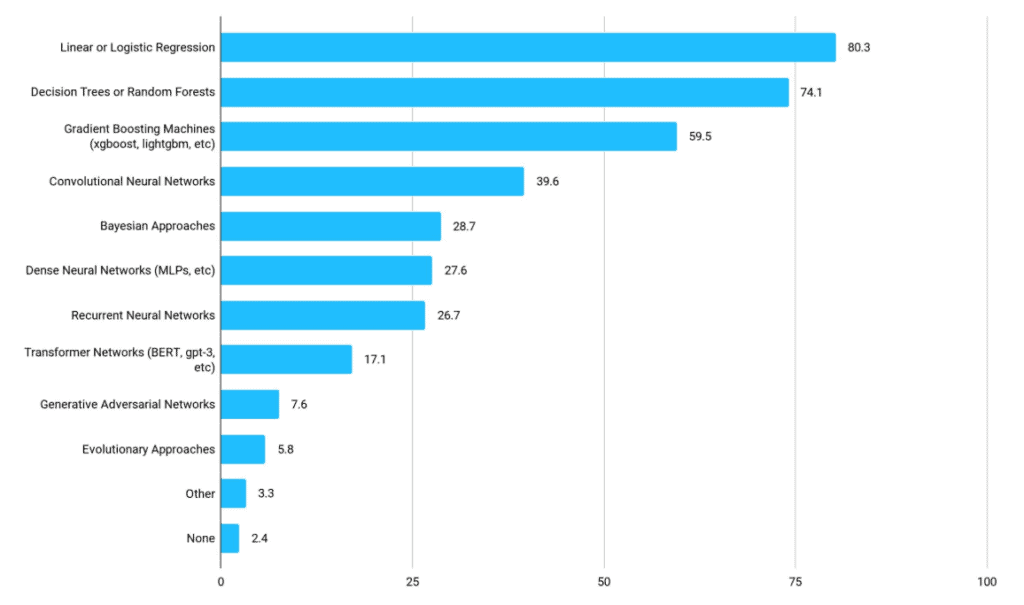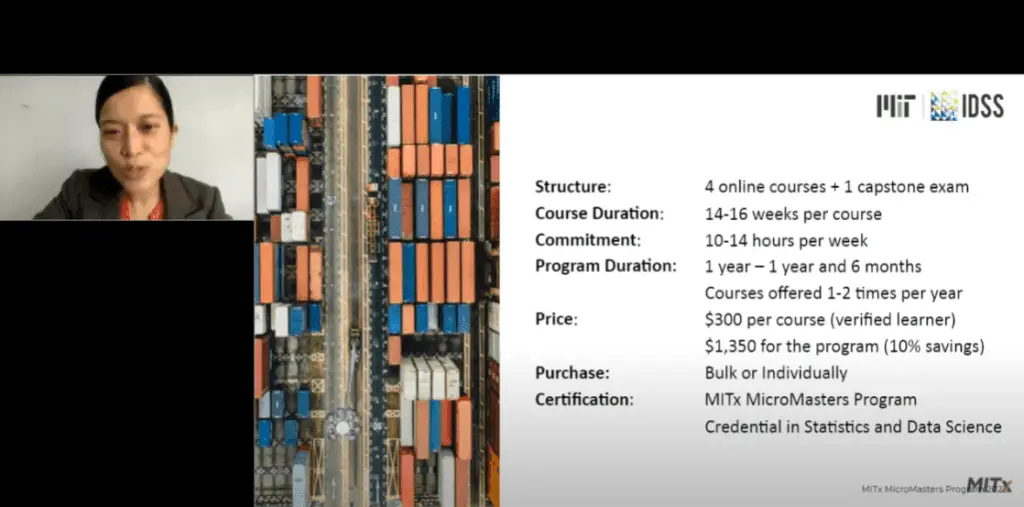This post may contain paid links to my personal recommendations that help to support the site!
You’ve been exploring data science certificates, including the MITx MicroMasters Program in Statistics and Data Science. But is the MITx MicroMasters Program in Statistics and Data Science worth it?
Here’s the short answer for you:
The MITx MicroMasters Program in Statistics and Data Science is worth it. Designed for intermediate data science learners, the MITx MicroMasters program is worth getting for its Master’s degree level of in-depth, instructor-led content, emphasis on statistics, structured schedule, and MIT branding for only USD $1500.

Starting this MicroMasters program might be quite a big decision for you to make.
That’s why I’ve done some research and have found 3 really good reasons why this MicroMasters program is worth it!
3 Reasons Why The MITx MicroMasters Program in Statistics and Data Science is Worth It
- Gives You A Good Foundation in Statistics
- Provides You With Instructor-Led Training in Essential Data Science Skills
- Motivates You to Learn With a Well-Structured Schedule
Want to know more about why I say that these reasons make the MicroMaster program worth it?
Make sure you read below for more information on each reason, cons about the program, and FAQs first!
1. The MicroMasters Program Gives You A Good Foundation in Statistics

If you’re going to be starting a career in data science, having some basic knowledge of statistics is essential to help you provide better data analysis to your stakeholders.
That’s where this MITx MicroMasters Program in Statistics and Data Science will help!
With 2 out of 6 courses focusing on statistics, you’ll be getting sufficient training in all the basics you need to know to get started for applications in data science.
The first statistics course you’ll have to complete is the first course in this MicroMasters program is Probability – The Science of Uncertainty and Data.

In this course, you’ll be taken through 10 rigorous training topics in statistics:
- Probability models and axioms
- Conditioning and independence
- Counting
- Discrete random variables
- Continuous random variables
- Further topics on random variables
- Bayesian inference
- Limit theorems and classical statistics
- Bernoulli and Poisson processes
- Markov chains (Optional topic)
In my experience with data science, I can agree that having a basic understanding of these concepts taught in the course can really help you out when you’re out there solving tough data analysis problems.
Here’s why know that many statistical concepts are important:
Having multiple statistical concepts under your belt can help you be adaptable in the data analysis you run. You’ll also be able to pick the right tests for the right analysis!
What I found really useful about this course was its heavy focus on probabilities, which sets you up for a good foundation for machine learning algorithms later on!
The first statistics course you’ll have to complete is the first course in this MicroMasters program is Fundamentals of Statistics.

In this course, you’ll learn more about typical statistical tools and models such as:
- Constructing estimators
- Hypothesis testing
- Confidence intervals
- Goodness of fit tests for models
- Linear prediction models (machine learning)
- Dimension reduction (machine learning)
With a greater emphasis on machine learning, this statistics course helps you gain a strong understanding of key applied statistics concepts.
I personally find this course much more helpful when applied to data science.
As a bioinformatics data scientist, I use dimension reduction very often through Principal Component Analysis (PCA), a type of machine learning model.
That’s why I’m a big fan of their emphasis on statistics in this program!
Here’s an introduction video of the MicroMasters program to help you get a better overview:
With such good introductions to the right statistical tools and tests, this MicroMasters Program should be worth your money!
Interested in just learning about machine learning?
The Stanford Machine Learning Course on Coursera is a great option I’d recommend.
2. The MicroMasters Program Provides You With Instructor-Led Training in Essential Data Science Skills
If there’s one thing special that this MITx MicroMasters Program has that other online courses do not, it is the instructor-led training in useful data science skills.
If you’re going to be learning about data science, you’ll ideally want to learn it from a person and not just any online course instructor.
Instructor-Led Training
In the MITx MicroMasters Program in Statistics and Data Science, you’ll be learning only from the best instructors at MIT.
Here’s the list of instructors I found on the program website:

Here’s why instructor-led programs are special:
- Learning from quality instructors
- Fixed deadlines
- A more personal touch
You’ll learn from qualified instructors who also teach at MIT (Massachusetts Institute of Technology). So this should be a similar learning experience as attending a class there!
Having an instructor-led program means that there will be fixed deadlines for assignments and exams.
Instructor-led courses give more of a personal touch since you’ll be able to ask personally your individual questions instead of watching a recording.
However, relying on such a program style sacrifices the program’s flexibility.
If you miss the enrollment schedule, you’ll have to wait until the next opening to enroll!
Training in Essential Data Science Skills
You’ll also be receiving training from these instructors on key data science tools and data analysis techniques.
Here’s a table summary of the skill and tools you’ll learn from each course:
| Course Title | Data Science Tools | Data Science Skills | |
|---|---|---|---|
| 1 | Probability – The Science of Uncertainty and Data | – | Statistics |
| 2 | Fundamentals of Statistics | – | Statistics |
| 3 | Machine Learning with Python: from Linear Models to Deep Learning | Python, Linear prediction models | Statistics, Machine Learning, Programming |
| 4 | Capstone Exam in Statistics and Data Science | Python | Statistics, Machine Learning, Programming |
| 5 | Elective: Data Analysis in Social Science—Assessing Your Knowledge OR | Python | Statistics, Machine Learning, Programming |
| 6 | Elective: Data Analysis: Statistical Modeling and Computation in Applications | Python | Statistics, Machine Learning, Programming |
As you can see, Python is a commonly used tool in this program and I’m all for it!
Python is used much more than R in data science for its flexibility and popularity.
Python programming is essential to getting into data science, and this MicroMasters Program is the perfect learning path to take you there, with in-depth explanations and programming exercises.
By learning Python, you’ll be able to access a large portion of the most commonly used machine-learning libraries that many qualified data scientists use often.
Here’s a list of some of the libraries found in Python:
Python also has many uses for data science in healthcare as well, if you’re interested in applications within that field.
Linear prediction models are also the most popular machine learning algorithm, according to Kaggle’s State of Machine Learning and Data Science 2021.

That’s why I really appreciate that this MITx MicroMasters Program in Statistics and Data Science teaches about linear prediction models!
If you’re intending to be a data scientist, the MITx MicroMasters Program in Statistics and Data Science is a good place for a solid foundation in the right skills.
However, this program doesn’t provide training on any basic computer science content.
3. The MITx MicroMasters Program Motivates You to Learn With a Well-Structured Schedule

The schedule of the MicroMasters Program in Statistics and Data Science follows a well-structured schedule.
This schedule is in sync with the school semester at MIT and is offered 1-2 times per year.
Here’s a summary of what the course schedule looks like if you enroll during their opening period:
| Course Title | Estimated Hours Per Week | Time to Complete | |
|---|---|---|---|
| 1 | Probability – The Science of Uncertainty and Data | 10–14 hours | 16 weeks |
| 2 | Fundamentals of Statistics | 10–14 hours | 17 weeks |
| 3 | Machine Learning with Python: from Linear Models to Deep Learning | 10–14 hours per week | 15 weeks |
| 4 | Capstone Exam in Statistics and Data Science | 10–14 hours | 4 weeks |
| 5 | Elective: Data Analysis in Social Science—Assessing Your Knowledge OR | 10–14 hours | 4 weeks |
| 6 | Elective: Data Analysis: Statistical Modeling and Computation in Applications | 10–15 hours | 16 weeks |
| Total | – | 1 year and 6 months |
As you can see, the program is well-structured and is based on 4 main pillars:
- Probability
- Statistics
- Machine Learning
- Applications of Machine Learning
In this program, you’ll take on 3 core courses and 1 elective course.
I really enjoy this format of learning because it resembles how an ACTUAL master’s program would go.
Here’s a video from MIT with more information about the courses in the MITx MicroMasters Program:
With such a structured program to guide you through tough concepts, you’re sure to be well-equipped with the right skillsets to get started in data science.
This course is perfect for those who do not want to pay such steep prices for a fully online Master’s degree or Nanodegree.
Moreover, the program can earn you an MITx Micromasters Program credential that will gain you access to apply for the MIT Doctoral Program in Social and Engineering Systems (SES).
Cons of The MITx MicroMasters Program in Statistics and Data Science
Every program has its flaws, and I’m sure you’ll want to know all about the course before you invest your money in enrolling in such a program.
Now, on to some cons of this MITx MicroMasters Program!
Con #1: Lack of Flexibility
You must have already read that I’m not a very big fan of having too rigid of a structure for learning.
In the MITx MicroMasters Program, you’ll need to follow the course structure to complete the program, which is about 1 year and 6 months long.
Some of you might not be able to commit to such a long and rigid schedule if you take the MITx MicroMasters Program in Statistics and Data Science.
However, here are some alternatives I recommend that can give you lots of flexibility in learning data science
Con #2: Cost
Another major downside of going for the MITx MicroMasters Program is the cost.
When compared to professional certificates out there, you’ll only spend a fraction of the cost of this MicroMasters Program.
Here’s a table with a simple price comparison:
As you can see, the cost of the MicroMasters Program is somewhere between a Master’s degree and a professional certificate.
This means that although the cost of this program might be steep, by the standards of common Master’s degrees, this is quite an affordable program, considering the same rigorous learning you’ll get!
My Take:
If you’re intending to go for a Master’s degree, take the MITx MicroMasters Program in Statistics and Data Science instead.
If you only want to learn essential data science skills, go for the HarvardX Data Science Professional Certificate instead.
More on the cost in the related questions below!
Related Questions
How Much Is MIT MicroMasters Data Science?
The MITx MicroMasters Program in Statistics and Data Science costs $1500 USD. However, this pricing may vary depending on promotions on EdX. The pricing of the MITx MicroMasters Program in Statistics and Data Science is typically reduced up to $1350 USD during promotional sales.
If you’re thinking of starting this MicroMasters program, do check their prices here before buying, since edX, the learning platform, tends to offer promotional sales.
At the point of writing this blog, it’s having a 10% discount and going at only $1350 USD!

If you’re unable to afford the program, you can also audit the individual courses in the program for free!

You can take the Audit track to complete the courses for free but with only a limited time period and without the MIT brand MicroMasters credential certificate.
How Long Does It Take To Complete the MIT MicroMasters in Data Science?
It takes 1 year and 6 months to complete the MITx MicroMasters Program in Statistics and Data Science. The MITx Data Science MicroMasters Program is as rigorous and challenging as an actual Master’s degree. The completion time may vary depending on previous programming knowledge, learning speeds, and time commitment.
Being a data scientist requires time and experience to learn the necessary skills so you should expect to learn them over a longer period of time.
If you’re striving to break into data science, having some time each week (10-14 hours) to learn from the MITx Data Science MicroMasters program can really help you make that career switch you always wanted!
Require a shorter program with lesser time commitment?
You’ll like the Data Scientist with Python Track on DataCamp, because it offers a more flexible learning approach, with more practical exercises.
How Do I Get Into MIT MicroMasters?
The MITx MicroMasters Program in Statistics and Data Science can be enrolled without admission. However, the MicroMasters Program is only offered 1-2 times per year and students can only enroll during these enrollment periods. Nonetheless, no prerequisite is required for enrollment in any MITx MicroMasters.
Read more in these MicroMasters programs over here.
Are edX MicroMasters Recognized?
The edX MicroMasters are recognized. The MicroMasters credential offered by edX is recognized by universities globally. Learners with the MicroMasters credential represent deep learning from top universities that showcase in-demand skills to employers. The MITx MicroMasters is recognized in the MIT SES Doctoral Program.
Read about the MIT MicroMasters Program here.
More on the MIT SES Doctoral Program here.
Are edX MicroMasters Accredited?
The edX MicroMasters are accredited. Earning a MicroMasters credential from edX is given a pathway to earning an advanced degree. Upon completion of the MITx MicroMasters program, learners can use the certificate to replace credit-bearing modules in many Master’s degrees from universities globally.
Read more on the latest university programs supporting this over here.
Final Thoughts
The MITx MicroMasters Program in Statistics and Data Science is great for intermediate learners who are serious and want some sophisticated and rigorous training to help them get into data science
If this article has been helpful, do consider using my affiliate link here, as it helps to support the site!
Thanks for reading!
My Favorite Learning Resources:
My Recommended Learning Platforms!
| Learning Platform | What’s Good About the Platform? | |
|---|---|---|
| 1 | Coursera | Certificates are offered by popular learning institutes and companies like Google & IBM |
| 2 | DataCamp | Comes with an integrated coding platform, great for beginners! |
| 3 | Pluralsight | Strong focus on data skills, taught by industry experts |
| 4 | Stratascratch | Learn faster by doing real interview coding practices for data science |
| 5 | Udacity | High-quality, comprehensive courses |
My Recommended Online Courses + Books!
| Topic | Online Courses | Books | |
|---|---|---|---|
| 1 | Data Analytics | Google Data Analytics Professional Certificate | – |
| 2 | Data Science | IBM Data Science Professional Certificate | – |
| 3 | Excel | Excel Skills for Business Specialization | – |
| 4 | Python | Python for Everybody Specialization | Python for Data Analysis |
| 5 | SQL | Introduction to SQL | SQL: The Ultimate Beginners Guide: Learn SQL Today |
| 6 | Tableau | Data Visualization with Tableau | Practical Tableau |
| 7 | Power BI | Getting Started with Power BI Desktop | Beginning Microsoft Power BI |
| 8 | R Programming | Data Science: Foundations using R Specialization | Learning R |
| 9 | Data Visualization | – | Big Book of Dashboards |

